Glossary
Below you will find the terms that are used by maiko everyday in the geisha district.
They are all unique, historical language, most of which don't make sense for ordinary Japanese.
- Agari-bana (Flower provided in closing)
- Tea provided upon arrival and departure
- Bappai (Penalty drink)
- Alcohol drink one must drink when they lose a game
- Dareka-iu (Say someone)
- To call in a geiko
- Erigae (Change collars)
- That maiko is promoted to geiko. The term is named after the custom that kimono collar for geiko is white, while for maiko red.
- Futozao (Broad neck)
- Broad neck shamisen
- Geimei (Stage name)
- The stage name that maiko or geiko is called at the party
- Genjina (Genjina)
- The professional name that hostesses (not maiko or geiko) is called at the party
- Goma (Sesame)
- Customers who are restless
- Gyokudai (The charge paid for geiko)
- The charge of the party

- Hakoya (Box maker)
- An occupation that does miscellaneous duties such as helping geiko get dressed in hikigi kimonos, transportation, correspondence and bill collection. The origin of the term is that people in this occupation used to carry shamisen case.
- Hangyoku (Half geiko)
- Girls in training who are not called out for the party. Young apprentice.
- Hannari (Elegant)
- Refined and calm, and having brightness, cheerfulness and glamour
- Hauta (Hauta)
- Short ballads accompanied on the shamisen, which became popular during the Edo period. Kouta (ditty, Japanese ballads) is a music form derived from hauta.
- Hidarizuma-wo-toru
(To take left skirt of kimono)
- To become a geiko. The term indicates that she sells only her artistic skills and would never sell herself. Traditionally geiko takes the hem of left skirt of kimono, while prostitutes right skirt of kimono.
- Hiku (To pull)
- To become a patron of a specific geiko. It is minimum requirement for patrons to pay at least more than geisha house. But in reality he is strongly expected to pay much more than that.
- Ippon (A single piece)
- A fully qualified geiko. Otherwise, the term means the charge of a party.
- Jakone (All sleep together in a huddle)
- To stay overnights together with geiko and maiko in the same room after geisha games have finished at the teahouse. However, they are not allowed to touch to geiko and maiko - they just have cheerful conversation.
- Jikata (Those in sitting position)
- Geiko who perform music at the party
- Jimae (Pay one's own expense)
- An independent maiko, or a geiko in most cases
- Karage (To tuck up)
- Ordinary kimono
- Kenban (Geisha call-house)
- People who mediate between the geisha houses and the restaurants or teahouses. Geisha call office.
- Koma-zashiki (Koma party)
- Party with a small number of customers
- Kounomono (Scented stuff)
- Japanese pickled vegetables (tsukemono)
- Kouyasan
- Toilet
- Kuromoji (Black characters)
- Toothpick
- Machiai (Meeting place)
- The parlor that orders dishes from caterers or other restaurants
- Magekae (Chignon change)
- After some years of experience, a maiko changes her hairstyle from the one called "cracking shinobu" to the other one called "ofuku". This indicates that she is now a senior, and has moved one step closer to a geiko.
- Minarai-san (Apprentice)
- Girls in training who are not called out for the party. Young apprentice.
- Mizuage (Hoisting from water)
- That one has completed her years as a maiko, and now becomes a geiko. At this time she changes her kimono and hairstyle. This doesn't mean she is forced to establish a relationship as a mistress with her patron.
- Mizugesho (Water makeup)
- To put on make-up applying the face powder that is dissolved in water. Basically this is how to put on tradtional Japanese make-up.
- Nenkiake (End of a term of service)
- Firstly, a geisha house covers the expenses needed for young apprentices and maiko to master the geisha skills on their behalf. Then they return the amount little by little from their regular income. It is called "nenki-ake" that they have finished repaying in full. After that, a geiko leaves the geisha house to become independent.

- Oaiso (Complaisant)
- Bill
- Obake (Spook, ghost)
- An event that takes place in the geisha district on the day marking the end of winter (setsubun). At this time geiko and maiko wear fancy dress costumes and tour around the parlors.
- Obokoi (Childlike and innocent)
- The word to describe a maiko who is girlish and cute.
- Ocha-wo-hiku(To grind tea)
- That a geiko is being free, not being called out by customers.
- Ochobo (Small)
- Apprentice girl
- Odaijin (Wealthy man)
- Good customer. Those who spends a lot of money to engage a geiko.
- Odebana
- The tea served upon arrival and departure
- Ohanadai (The price of a flower)
- The charge of services at the party
- Ohana wo tsukeru (To put flowers)
- To make a reservation
- Ohito-san (Some person)
- Acquaintance, customer
- Ohiya (Something cold)
- Water
- Oka-san (Mother)
- Proprietress of geisha house (okami)
- Okiya (Geisha house)
- The house where maiko is trained and live their life until they have become full-fledged. They are taken care of everything: their clothes, food and shelter.
- Okobo (A type of wooden clogs)
- A pair of wooden clogs (geta) with a height of about 10 cm for maiko. Also called "koppori".
- Okouko (Scented stuff)
- Japanese pickled vegetables (tsukemono)
- Onee-san (Older sister)
- Senior geiko
- Onii-san (Older brother)
- This is a way of how the customers are called. It is considered to be a good manner to call the customers without revealing their real names.
- Osumoji
- Sushi
- Otabakobon (An astray)
- Intrusive person
- Oteshio / Otesyo (Hand salt)
- Small plates
- Otokoshi
- Men
- Oto-san (Father)
- This is a way of how the customers are called. It is considered to be a good manner to call the customers without revealing their real names.
- Otsu
- Stylish, chic
- Oyakusoku (A promise)
- A party reservation
- Ozashiki-kago (A party basket)
- A basket that is carried when maiko goes out to the party. Typically, they put a folding fan, business cards, slips of paper printed with maiko's name (senjufuda) inside.
- Sakate-no-sakatsugi
(A reverse way to pour drink for someone with reverse hand)
- A completely wrong way to pour drink for customers, meaning "Die".
- Sanbon-asi (Three legs)
- When a maiko dresses up on formal occasions such as her debut day and the opening ceremony, they intentionally leave an area on her nape without putting on make-up. The area looks like three legs of something.
- Sara-neburi (Those who lick plates)
- Bad customer
- Sashikomi-han (Those who are inserted)
- Customer who drops in with no appointment
- Senju-fuda
- Slips of paper printed with maiko's name. This is something like a name card. Maiko choose its design, and place an order by herself. They use slips with different designs according to the season.
- Senkoudai (The charge of incense stick)
- Charge of the party
- Shikomi-san (People in training)
- Girls in training who are not called out for the party. Young apprentice.
- Sonnari
- Ordinary kimono
- Sukiyan
- Loved one
- Tachikata (Those in standing position)
- Geiko who dance at the party
- Tekake (Someone who is meddled with)
- Mistress
- Toude (Excursion)
- Going out away from the geisha district
- Yakuyoke (Protective charm)
- Maiko's red eye shadow
- Youhatsu (Western hairstyle)
- A party where geisha dresses ordinary kimono. This is unlikely to happen in Kyoto.




